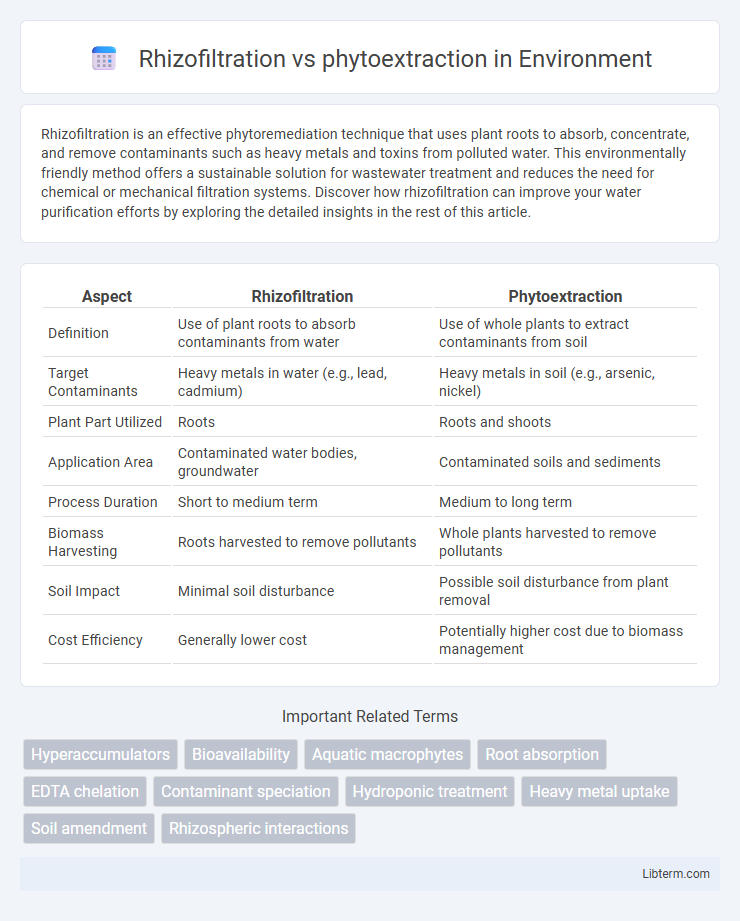Rhizofiltration is an effective phytoremediation technique that uses plant roots to absorb, concentrate, and remove contaminants such as heavy metals and toxins from polluted water. This environmentally friendly method offers a sustainable solution for wastewater treatment and reduces the need for chemical or mechanical filtration systems. Discover how rhizofiltration can improve your water purification efforts by exploring the detailed insights in the rest of this article.
Table of Comparison
| Aspect | Rhizofiltration | Phytoextraction |
|---|---|---|
| Definition | Use of plant roots to absorb contaminants from water | Use of whole plants to extract contaminants from soil |
| Target Contaminants | Heavy metals in water (e.g., lead, cadmium) | Heavy metals in soil (e.g., arsenic, nickel) |
| Plant Part Utilized | Roots | Roots and shoots |
| Application Area | Contaminated water bodies, groundwater | Contaminated soils and sediments |
| Process Duration | Short to medium term | Medium to long term |
| Biomass Harvesting | Roots harvested to remove pollutants | Whole plants harvested to remove pollutants |
| Soil Impact | Minimal soil disturbance | Possible soil disturbance from plant removal |
| Cost Efficiency | Generally lower cost | Potentially higher cost due to biomass management |
Introduction to Rhizofiltration and Phytoextraction
Rhizofiltration and phytoextraction are two vital phytoremediation techniques used to remove contaminants from the environment using plants. Rhizofiltration specifically targets the uptake and accumulation of heavy metals and toxins from water through plant roots, effectively filtering polluted water bodies. Phytoextraction, on the other hand, involves the absorption and concentration of pollutants from soil into the above-ground parts of plants, facilitating contaminant removal through biomass harvesting.
Defining Rhizofiltration
Rhizofiltration involves the use of plant roots to absorb, concentrate, and precipitate heavy metals or contaminants from polluted water, making it an effective method for treating wastewater and groundwater. Unlike phytoextraction, which targets pollutant removal from soil through the harvesting of aerial plant parts, rhizofiltration specifically addresses water purification by utilizing the root zone. This technique leverages hyperaccumulator species with extensive root systems capable of binding and extracting soluble toxins from aquatic environments.
Understanding Phytoextraction
Phytoextraction involves plants absorbing contaminants, primarily heavy metals, from soil through their roots and translocating them to above-ground tissues for harvesting and removal. This process targets persistent pollutants, enhancing soil remediation by concentrating toxins in harvestable plant parts, contrasting with rhizofiltration, which primarily filters contaminants from water via root systems without significant translocation. Understanding phytoextraction's mechanisms improves bioremediation strategies for polluted sites by leveraging specific hyperaccumulator species optimized for contaminant uptake and biomass production.
Key Differences Between Rhizofiltration and Phytoextraction
Rhizofiltration primarily targets the removal of heavy metals and pollutants from contaminated water through root absorption and accumulation, while phytoextraction focuses on extracting contaminants from soil into harvestable plant biomass. Rhizofiltration employs aquatic or hydroponically grown plants, whereas phytoextraction uses terrestrial plants adapted to metal-rich soils. The ease of biomass disposal differs as rhizofiltration biomass is typically harvested from water systems, contrasting with phytoextraction where soil remediation and metal recovery require managing larger volumes of contaminated plant material.
Mechanisms of Metal Uptake in Each Method
Rhizofiltration involves the adsorption and absorption of heavy metals onto the root surfaces and outer root tissues, where root exudates chelate metals, facilitating their immobilization. Phytoextraction, on the other hand, relies on the active uptake of metals from soil into the plant's root system, followed by translocation to above-ground tissues through xylem transport. Differences in root architecture and metal transporter proteins determine the efficiency and specificity of metal uptake mechanisms in each method.
Suitable Plant Species for Rhizofiltration and Phytoextraction
Suitable plant species for rhizofiltration include water hyacinth (Eichhornia crassipes), Indian mustard (Brassica juncea), and sunflower (Helianthus annuus), which excel at absorbing heavy metals and contaminants through their root systems in aquatic environments. Phytoextraction commonly involves hyperaccumulators like Alyssum spp., Pteris vittata, and Thlaspi caerulescens, which uptake and concentrate metals such as nickel, arsenic, and zinc from contaminated soils. Both techniques rely on plant species with high metal tolerance and accumulation capacity, but rhizofiltration targets pollutant removal from water, whereas phytoextraction focuses on soil remediation.
Environmental Applications and Effectiveness
Rhizofiltration effectively removes contaminants like heavy metals and radionuclides from aqueous environments by accumulating pollutants in plant roots, making it suitable for treating wastewater and polluted groundwater. Phytoextraction targets soil contamination by absorbing and translocating heavy metals from soil to harvestable plant shoots, enabling site remediation through crop harvesting. Both methods offer eco-friendly remediation, but rhizofiltration is more efficient in water treatment, while phytoextraction excels in restoring contaminated soils.
Advantages and Limitations of Rhizofiltration
Rhizofiltration effectively removes heavy metals and radionuclides from contaminated water using plant roots, offering a cost-efficient and environmentally friendly remediation method compared to phytoextraction, which targets soil contaminants. Advantages of rhizofiltration include rapid contaminant uptake, potential reuse of biomass, and minimal disturbance to soil structure. Limitations involve dependency on water quality, limited effectiveness against organic pollutants, and the necessity for careful disposal of contaminated plant material to prevent secondary pollution.
Pros and Cons of Phytoextraction
Phytoextraction effectively removes heavy metals from contaminated soils by accumulating pollutants in harvestable plant biomass, offering a sustainable and cost-effective remediation method. However, the process can be slow, dependent on plant growth rates, metal bioavailability, and may require multiple cropping cycles, limiting its efficiency for highly contaminated sites. Phytoextraction also poses risks of metal re-release into the environment if plant biomass is not properly managed post-harvest.
Choosing the Right Phytoremediation Technique
Rhizofiltration targets heavy metals in water by exploiting plant roots to absorb and concentrate contaminants, making it ideal for treating wastewater and aquatic environments. Phytoextraction involves harvesting above-ground plant tissues that accumulate pollutants from soil, providing an effective solution for remediating heavy metal-contaminated soils. Selecting between rhizofiltration and phytoextraction depends on contamination type, environmental media, and cleanup goals to maximize remediation efficiency.
Rhizofiltration Infographic

 libterm.com
libterm.com